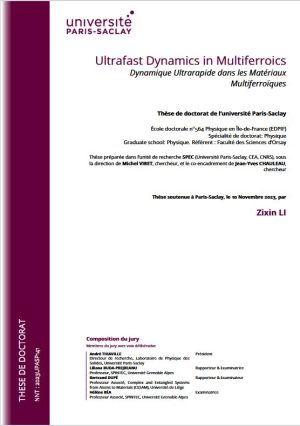Abstract:
Antiferromagnetic (AF) materials possess resonance frequencies reaching the THz range, which is two orders of magnitude higher than those of ferromagnets. Many antiferromagnets, such as the prototypical AF Nickel Oxide NiO, are insulating oxides in which the energy dissipation of the spin dynamics is low due to the localized nature of electrons. Their high resonance frequency and low energy dissipation have triggered considerable interest as the modern electronics industry is hitting the walls of frequency and dissipation, and is reaching size limits. Moreover, due to their antiparallel arrangement, the spin structures in AFs are robust and not easily affected by external fields. Because they do not produce stray fields outside the sample, these magnetic materials bring challenges to probe and manipulate, especially at this early stage of their development.
Consequently, modelling and numerical simulations of their spin dynamics are crucial in understanding the relevant microscopic processes at the picosecond time scale and in predicting the critical conditions for some interesting physical phenomena. Besides their magnetic order, some materials are also multiferroic, i.e. they possess more than one ferroic order simultaneously. As an archetype of such materials, Bismuth Ferrite BiFeO₃ (BFO) is at ambient conditions a ferroelectric antiferromagnet. The AF spin orientation in BFO is modulated by an incommensurate cycloidal order, which is induced by the magneto-electric interaction. This interaction couples the magnetic and ferroelectric orders, providing an extra handle to manipulate the spin structure, as well as the possibility of creating topological entities.
In this dissertation, we focused our study on NiO and BiFeO₃. We based our modelling of the spin dynamics on the experimentally measured parameters and conducted theoretical and numerical studies. We studied the spin wave propagation in NiO starting from trivial geometries to more complex ones, as well as the interaction between spin waves in a junction. In order to model BFO, we developed a new code from scratch to efficiently simulate its spin dynamics with GPU acceleration. This code vastly boosted the computational speed and made possible a series of studies. We then addressed the phase transition of its spin texture under a strong magnetic field of different orientations. We simulated its spin dynamics under the effect of a spin-transfer torque pulse. We also modelled spin textures in ferroelectric domain walls and more exotic polarization configurations. In the end, we uncovered the critical conditions for the existence and stability of AF skyrmions in BFO, studied their dynamical properties, and the possible conditions for their nucleation.
This work aims to provide a useful reference for future experimental studies in the new field of antiferromagnetic spintronics.
Keywords: Simulation, Ferroics, Magnetism.
Dynamique ultrarapide dans les matériaux multiferroïques
Résumé :
Les matériaux antiferromagnétiques (AF) possèdent des fréquences de résonance atteignant la gamme du THz, soit deux ordres de grandeur supérieurs à ceux des ferromagnétiques. De nombreux antiferromagnétiques, tels le prototype oxyde de nickel NiO, sont des oxydes isolants dans lesquels la dissipation d’énergie de la dynamique de spin est faible en raison de la nature localisée des électrons. Leur fréquence de résonance élevée et leur faible dissipation d’énergie ont récemment suscité un intérêt considérable alors que l’industrie électronique moderne se heurte à des limites dures en fréquence et dissipation et atteint aussi ses limites en taille. Aussi, en raison de leur disposition antiparallèle, les textures de spin dans les AF sont robustes et ne sont pas facilement affectées par les champs extérieurs. Parce qu’ils ne produisent pas de champs de fuite, ces matériaux magnétiques sont très difficiles à sonder et à manipuler, en particulier à ce stade précoce de leur développement.
Par conséquent, la modélisation et les simulations numériques de leur dynamique de spin sont cruciales pour comprendre les processus microscopiques pertinents à l’échelle de la picoseconde et pour prédire les conditions critiques de certains phénomènes physiques intéressants. Outre leur ordre magnétique, certains de ces matériaux sont également multiferroïques, c’est-à-dire qu’ils possèdent simultanément plusieurs ordres ferroïques. La ferrite de bismuth BiFeO₃ (BFO) en est l’archétype, étant dans les conditions ambiantes, antiferromagnétique et ferroélectrique. L’orientation des spins AF dans le BFO est modulée par un ordre cycloïdal incommensurable, induit par l’interaction magnéto-électrique qui couple les deux ordres. Cette interaction offre ainsi un levier supplémentaire pour manipuler la structure de spin, ainsi que la possibilité de créer des entités topologiques.
Dans cette thèse, nous avons concentré notre étude sur NiO et BiFeO₃. Nous avons basé notre modélisation de la dynamique de spin sur les paramètres mesurés expérimentalement et mené des études théoriques et numériques. Nous avons étudié la propagation des ondes de spin dans NiO, dans des géométries variées, ainsi que l’interaction entre les ondes de spin dans une jonction. Afin de modéliser BFO, nous avons entièrement développé un nouveau code pour simuler efficacement sa dynamique en profitant d’une considérable accélération GPU. La vitesse de calcul largement amplifiée a rendu possible une série de simulations. Nous avons par exemple étudié la transition de phase de la texture de spin de BFO sous fort champ magnétique d’orientations différentes. Nous avons simulé sa dynamique de spin sous l’effet d’une impulsion de couple de transfert de spin. Nous avons également modélisé des textures de spin dans des parois de domaines ferroélectriques et des configurations de polarisation plus exotiques. Enfin, nous avons mis à jour les conditions critiques pour l’existence et la stabilité des skyrmions AF dans le BFO, étudié leurs propriétés dynamiques et les conditions possibles pour leur nucléation.
Ce travail vise ainsi à fournir une référence utile pour de futures études expérimentales dans le nouveau domaine de la spintronique antiferromagnétique.
Mots-clés : Modélisation, Ferroïques, Magnétisme.




